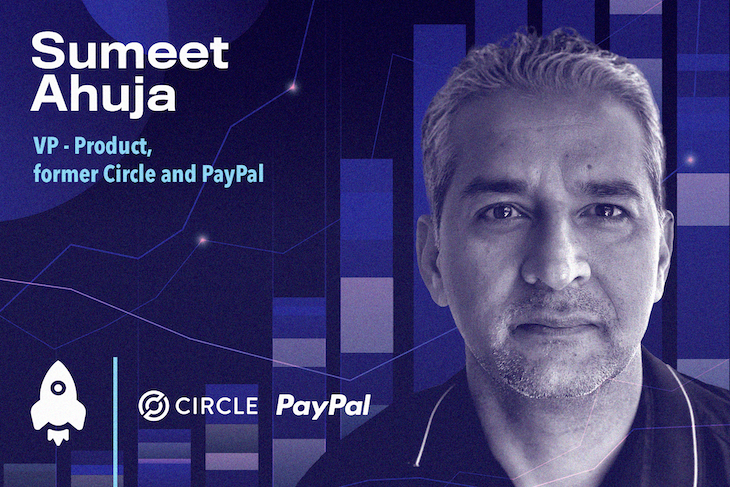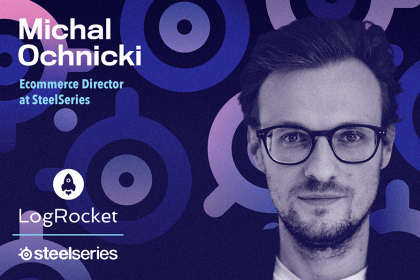Sumeet Ahuja is the former VP of Product at Circle and prior product leader at PayPal. A product advisor and investor, Sumeet is a frequent guest lecturer at USC’s Marshall School of Business.

We sat down with Sumeet and discussed the necessity of community building in product, the rapid diffusion of innovation across the world, and the change in emphasis from rapidly pushing products to market to creating impact as fast as possible.
For one, my journey has not been linear. Some of it has been by design and some of it by destiny. Sometimes I wonder why I pick the most complex spaces to dive into, but it’s something I naturally gravitate toward. There are a lot of nervous moments in these spaces. I have a high curiosity and want to know more and get into more undefined spaces.
It’s also the nature of the work involved in these disruptive spaces. It is quite interdisciplinary. When you’re in a disruptive space, you have to solve a lot of things. It involves an integrated web of many things that have to come together, and I enjoy that piece. There’s intense, frequent context switching from strategy to execution.
There are a few big patterns. First, a change in the stakeholder set — the stakeholders that I, as a product manager, have to be accountable to and work with or be cognizant of. You’re no longer narrowing in on one thing; you think about everyone.
If you’re working in FinTech, crypto and blockchain, AI, or these new emerging spaces in Web 2.0 and Web 3.0, you need to think about governance. Who is on your compliance team, who’s on your regulatory and policy affairs teams? Who are the ones who are working with consumer protection agencies and so on?
It’s no longer about “Let me do this on my own, let me build a walled garden.” No, let’s collectively pull our resources, let’s come in together, set standards, influence the direction in the market, and influence where the regulators are going.
Further, product today is no longer about building a product or a large company and just launching in the market. Successful products are not created in silos but with the power of ecosystems and communities. Companies are leveraging the power of communities, experts, and influencers. You can’t succeed today, in my opinion, without that.
A big change has been the mindset around culture and product too. We now often hear about “tech for good.” Companies, as well as the talent pool entering the product function today, are not just looking at building new technologies and products, but also at driving good through product and tech.
Yes, absolutely. In the case of startups, for example, especially in the Web3 space, they’re still in a very embryonic stage, but almost every single company in the Web3 space has Discord channels and other community forums. They’ve got events throughout the year where they’re bringing in developers and ecosystem partners to build together. It’s co-invention.
It’s a sense of camaraderie that we are in this together — we’re trying to change and break the mold of legacy infrastructure. A lot of the smallest startups cannot do it on their own. You need it from the bottom of the organization, from a product manager, marketers, developers, and the ecosystem, all working together. At smaller companies, you will find the community-centric mindset across all levels of the company, but you may not find as much in larger, more established Web2 companies, for example, as the dynamics are different.
However, things are changing rapidly and even legacy companies are taking a page out of the playbook of startups to build and foster communities. Community building is a part of pretty much every function today.
It’s important to have speed to development and speed to market, but really what we should be after is a mindset toward the actual impact taking place in the market and in the hands of the customer. We’ve seen that the financial services space has absolutely been the focus area for use cases in the blockchain and cryptocurrencies domain. A lot of the work that has gotten attention and adoption has been around crypto trading.
There are obviously people in the world who have maximized the opportunity with cryptocurrencies and benefited substantially, but there are also some who have been negatively impacted as well. But at a much broader level now, you will find companies in this space focusing on cross-border trade, supply chain management, real-world asset tokenization, and healthcare by using the blockchain. There’s a tremendous focus on remittances using stablecoins as that helps solve some of the most pressing economic issues for high inflation and volatile currencies.
That’s where the impact piece comes in, as opposed to a smaller segment of crypto-savvy investors who may be reaping the benefits of crypto trading and investing.
I do believe that in product, some things shouldn’t change. It’s hard to do that, but these are some of the basics on which products get built, marketed, launched, and managed.
Honestly, in my opinion, three things shouldn’t change:
One of the things I’ve seen more so in the last five to seven years is that with these new technologies, many product professionals lose sight that we still operate in a world of large legacy infrastructure. From a technology and operations perspective, yes, you may be brand-spanking-new to an industry or the working world as a product leader, but you will have to build products that talk back to legacy. Interoperability and integrations are key.
I think the best approach is to first dissect GTM and understand its piece-parts, and then see if and where generative AI can fit into GTM.
To me, GTM begins even before a product gets built and even after it’s been launched. In fact, it’s visible even when you’re running and building the product. You can have GTM aspects and market research in writing content or building collateral. GTM shouldn’t be thought about as just a marketing aspect, but as multiple aspects within the product space, extending to customer support and training.
A lot of companies today are already using this technology for social media updates, blog posts, product descriptions, data analysis, etc. AI is really well-suited for analyzing large amounts of data quickly. So, using generative AI for analysis and personalization, it’s a no-brainer. I’ve also seen a rise in the use of AI in customer support chatbots and A/B testing analysis.
But, you have to be careful about things where there is a high degree of, let’s say a hyperlocal context for GTM activities, or where there are ethical considerations around bias or fairness. The challenge is that AI is like a hammer and everything looks like a nail these days. There are places where you want to be smart about how you use it — especially where there’s a human interaction element needed.
I think we are witnessing a lot of changes in the innovation dynamic around the world. It’s a really exciting phase in my opinion, because I truly believe that it’s all for good. To me, if you really look around today, the creative aspect of technology is not just coming from one corner of the world, it’s become very diffused. There’s no more central hub of innovation.
Innovation is not just looking at speed to market anymore, it’s also speed to impact. Products are built faster now, maybe because of a change in how they’re built, the evolution of software development cycles, or the shift toward risk-taking to get stuff out there quickly to drive impact.
Another thing I think is really important is co-invention. Companies, developers, innovators, and entrepreneurs today are forming communities. They are no longer waiting to solve every single thing on their own. I think that approach will become the biggest change. The nature of interdependence is a lot more today than it used to be before.
I went to USC for my MBA and my relationship with them has been long-standing. I was very involved in recruiting efforts when I was back at PayPal, and one thing led to the other and I began to teach some cohorts there as a guest lecturer on product operations, product management, and product marketing. I’ll actually also be picking up and accelerating my teaching career and teaching next spring at a university in Barcelona.
In the past, product wasn’t a focus area taught at universities; it was always considered part of the job search. You would have the career departments teaching and mentoring students on how to build a product career and they didn’t have courses on it. But that’s changed. Product careers today are probably one of the most sought-after, especially for graduate students. Colleges are moving toward building the product function into their curriculum.
That’s a tough one. Honestly, it really depends on what you’re solving — are you in a growth and scaling phase? Do you need a deeper subject matter expert or someone with a broader, general management mindset?
Who you bring on the team is probably one of the most critical decisions that a leader makes. In general, there’s got to be the right fit — not just in skill set, but also personality and culture. What may be right for you may not be right for me or somebody else. As cliche as it sounds, you want to bring in people who can be actually set up for success.
A big mistake that people make is hiring for a specific point in time. You have to keep in mind that hiring people is expensive, but replacing them or bringing somebody new is even more expensive. You’re solving for what you need, but you’re also really making them part of this success equation. To me, the hallmark of success in bringing somebody on is to have them move on to something bigger and better. You’ll lose them at a certain point in time and that’s okay.
LogRocket identifies friction points in the user experience so you can make informed decisions about product and design changes that must happen to hit your goals.
With LogRocket, you can understand the scope of the issues affecting your product and prioritize the changes that need to be made. LogRocket simplifies workflows by allowing Engineering, Product, UX, and Design teams to work from the same data as you, eliminating any confusion about what needs to be done.
Get your teams on the same page — try LogRocket today.
Want to get sent new PM Leadership Spotlights when they come out?

Michal Ochnicki talks about the importance of ensuring that the ecommerce side of a business is complementary to the whole organization.

Christina Valls shares how her teams have transformed digital experiences at Cedars-Sinai, including building a digital scheduling platform.

Red-teaming reveals how AI fails at scale. Learn to embed adversarial testing into your sprints before your product becomes a headline.

Cory Bishop talks about the role of human-centered design and empathy in Bubble’s no-code AI development product.